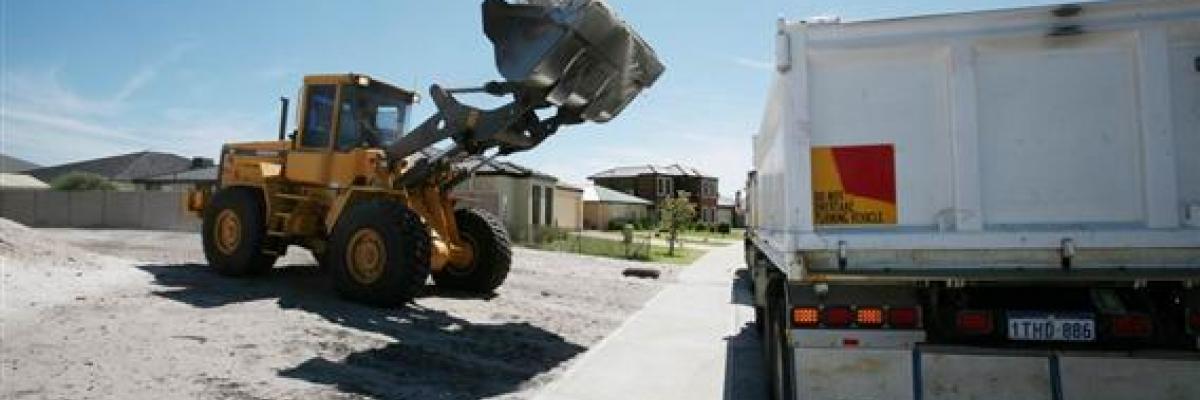During the construction phase of any development measures must be taken to minimise the impact of the construction on:
-
Existing property owners within the area
-
Natural environment such as our waterways
-
Existing infrastructure such as street drainage, footpaths, power and light poles, street signs and street trees
-
Road users and pedestrians wishing to pass the building site
-
Other builders on other properties.
The benefits of good construction management principles for the builder are:
-
A better looking, more marketable site
-
Less downtime after wet or windy weather
-
Fewer public complaints
-
Better public image
-
Reduced stockpile losses
-
Safety for its employees and the public.
Ensure approval has been obtained to store materials on the verge
Where it is proposed to use any part of a road reserve or other public property for safety works, scaffolding, storage or placement of temporary site buildings and the like, approval from the City must first be obtained.
Where it is proposed to use any part of an adjoining public or private property to undertake part of the building works, whether it be for storage, scaffolding or access to the building site, then permission in writing from the owner of that land must be obtained by the builder prior to utilizing that land.
Fencing of Building Sites
Building site fencing must be provided where required by Worksafe WA. Fencing must be a minimum 1.8m high chain link wire or other as specified by Worksafe, and must be contained within the property boundary of the building site.
Where fencing is required to be placed within an adjoining public or private property, then the permission of the owner of that property must be obtained.
Any fencing in a road reserve will be considered based on its impacts on pedestrian access past the site and its impacts on road safety for vehicle users in terms of sight lines for passing traffic and for vehicles entering and leaving the site.
Access points to the building site
Where possible, the entry exit point to a building site is restricted to one point and must be clearly defined. The location of the access point needs to be assessed on the basis of the number and type of vehicles that will need to access the site and the impact this will have on other road users.
Vehicle entry points to a building site must have a minimum width of 3m and a maximum width of 6m.
The surface of the access point must be suitably stabilized using crushed limestone or other temporary stable surface that will not easily erode and is suitable for the type of vehicles that need to access over it. Where an access road slopes towards the street, a diversion hump or cut off drain should be provided to direct any stormwater to the side where it can be disposed into an easily drained soil or temporary soak well, to prevent runoff into the street and street drainage system.
This will ensure that:
-
Sand does not end up on the street and street drainage systems, waterways or adjoining properties
-
Minimal sediment will be tracked off site
-
Disturbance to other parts of a site is minimal
-
Any risk of damage to infrastructure such as kerbs and footpaths is confined
-
Better access for delivery vehicles
-
Certainty for other road users of where vehicles will be entering and leaving the building site
Responsibilities associated with wind, water and litter
It is the builder's responsibility to ensure that sand, buildings and building material and associated litter is properly contained within the building site. In order to prevent the impacts associated with wind, water and litter from leaving a building site, the following measures should be adopted:
-
All building materials and any general litter that is susceptible to being lifted by wind is to be suitably weighted, tied down or placed in covered bins
-
Any minor buildings such as site toilets, power poles and site building are to be adequately tied down to prevent overturning, becoming airborne, or from being washed away
-
Sand stockpiles are placed in protected locations or suitably screened with a wire and shade cloth screen to a height of 1.8m
-
Sand embankments having a maximum slope of 1:2
-
Sprinklers used on sand stockpiles during periods of heavy winds
-
Watering of vehicular access ways during periods of windy weather
-
Ensuring site vehicles and workers traffic are confined to specified areas
-
Providing stabilized access ways
-
Connecting roof stormwater downpipes at the same time as installation of the roof cover
-
Providing temporary drainage gullies and soak pits to ensure that stormwater and sand does not end up on the street and street drainage systems, waterways or adjoining properties.
An infringement of $500 may be issued to any person, builder or contractor where it is found that litter leaves a building site under the provisions of the Litter Act. A maximum fine of $5,000 and daily penalty of $500 applies where a prosecution is undertaken.
